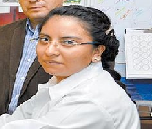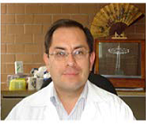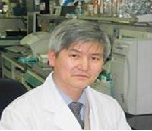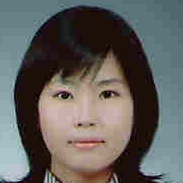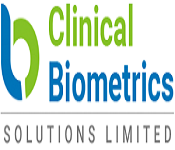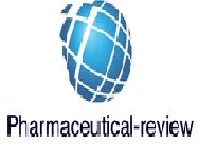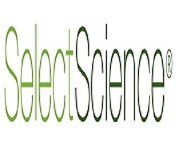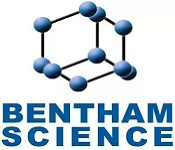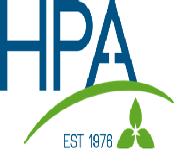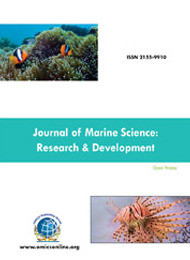Theme: Nature as a Medicine
Natural Products 2017
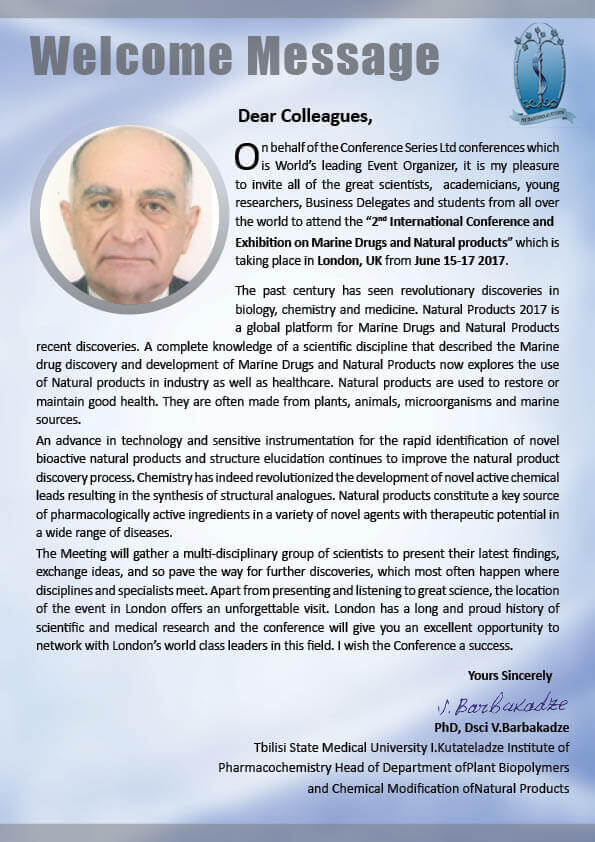
ConferenceSeries Ltd Conferences invites all the participants from all over the world to attend '2nd International Conference and Exhibition on Marine Drugs and Natural Products' during June 15-17, 2017 in London, UK which includes prompt keynote presentations, Oral talks, Poster presentations and Exhibitions.
Natural Products 2017 is a global platform for Marine Drugs and Natural Products recent discoveries and developments in Marine drugs discovery and natural produced drugs. A complete knowledge of a scientific discipline that described the Marine drug discovery and development and Marine Drugs and Natural Products now explores the use of Natural products in industry as well as healthcare. ConferenceSeries Ltd organizes a conference series of 3000+ Global Events inclusive of 1000+ International Conferences, 1000+ Symposiums and 1000+Workshops and Preconference workshops in USA, Europe & Asia with support from 1000 more scientific societies and publishes 700+ Open access Journals which contains over 50000 eminent personalities, reputed scientists as editorial board members.
Track 1: Natural Products
Natural products are naturally occurring substances that are used to restore or maintain good health. They are often made from plants, animals, microorganisms and marine sources. They come in a wide variety of forms like tablets, capsules, tinctures, solutions, creams, ointments and drops. Natural products are used and marketed for a number of health reasons, like the prevention or treatment of an illness or condition, the reduction of health risks, or the maintenance of good health. They must be safe to be used as over-the-counter products. Products needing a prescription are regulated as drugs. Natural Products are used for various purposes like skin and hair care, dietary supplement, baby care, organic and natural herbal products.
Related Conferences:
International Conference on Ayurveda, Homeopathy and Chinese Medicine, May 18-19, 2017 Munich, Germany; 3rd Global Summit on Herbals & Natural Remedies, June 29 - July 01, 2017 Bangkok, Thailand; 3rd Global Summit on Plant Science, August 07-09, 2017 Rome, Italy; 5th International Conference and Exhibition on Pharmacognosy, Phytochemistry & Natural Products, August 07-09, 2017 Beijing, China; 7th International Conference and Exhibition on Traditional Alternative Medicine, September 5-7, 2017 Paris, France; Chemical and Biological Approaches to Therapeutically Relevant Natural Products and Bioactive Compounds, July 29-30, 2017, Andover, NH; 19th International Conference on Natural Products, June 28 - 29, 2017, London, United Kingdom; Synthetic Biology for Natural Products Conference, March 05-08, 2017, Cancun, Mexico; 3rd Natural Products Conference, March 20-23, 2017, Cancun, Mexico; 65th International Congress and Annual Meeting of the Society for Medicinal Plant and Natural Product Research, September 3-7, 2017, Basel, Switzerland; Natural Products, July 31 - August 5, 2016 Proctor Academy, Andover, NH.
Related Societies
Australian Society of Plant Scientists (ASPS), European Plant Science Organization (EPSO), International Crop Science Society (ICSS), International Society for Horticultural Science (ISHS), Botanical Society of China (BSC), Chinese Society of Plant Biology (CSPB), Crop Science Society of China (CSSC), Indian Society of Plant Physiology (ISPP), Japanese Society for Plant Cell and Molecular Biology (JSPCMB), Japanese Society of Plant Physiologists (JSPP)
Track 2: Novel Sources and Approaches to Natural Products
Natural products (secondary metabolites) have been the most successful source of leads for potential drug discovery. Natural products have been well documented for their medicinal uses for thousands of years. Plants have evolved and adapted over millions of years to withstand bacteria, insects, fungi and weather to produce unique, structurally diverse secondary metabolites. Their ethnopharmacological properties have been used as a primary source of medicines for early drug discovery. Macro and micro fungi have been part of human life for thousands of years. They were used as food (mushrooms), in preparation of alcoholic beverages (yeasts), medication in traditional medicine and for cultural purposes
Related Conferences:
5th International Conference on Oceanography and Marine Biology, October 16-18, 2017 Seoul, South Korea; 7th Global Summit on Agriculture & Horticulture, August 10-12, 2017 Beijing, China; 2nd International Conference on Green Energy & Expo, June 5-7, 2017 Valencia, Spain; 4th Asia-Pacific Biotech Congress, April 10-12, 2017, Indonesia; 3rd International Conference & Expo On Drug Discovery & Designing, June 26-28, 2017 Philadelphia, USA; Natural Products Expo West, March 8-12, 2017, CA, USA; 2nd International Conference on Herbal and Traditional Medicine, January 25 - 27, 2017, Bangkok, Thailand; International Conference on Natural Product Biotechnology, September 25-27 2017, Aberdeen, Scotland; 3rd Mediterranean Symposium on Medicinal and Aromatic Plants, April 13-16, 2017, Kyrenia, Cyprus; Healthplex Expo 2017 and Natural & Nutraceuticals Products, June 20-22, 2017, Shanghai, China; Global Summit on Plant Science, October 06-08, 2016, London, UK
Related Societies
American Society of Plant Biologists (ASPB), Australian Society of Plant Scientists (ASPS), Argentinean Society of Plant Physiology (SAFV), American Society of Agronomy (ASA), Argentinean Society of Plant Physiology (SAFV), African Crop Science Society (ACSS), Brazilian Society of Plant Physiology (SBFV), Canadian Society of Plant Biologists (CSPB), Chile’s National Network of Plant Biologists (CNNPB), Crop Science Society of America (CSSA)
Track 3: Natural Products Chemistry
The investigation of biological and chemical properties of natural products for the past two centuries has not only produced drugs for the treatment of several diseases, but has instigated the development of synthetic organic chemistry and the arrival of medicinal chemistry as a major route to discover efficacious and novel therapeutic agents. Structural alteration of natural compounds or synthesis of novel compounds, based on designs following a natural compound scaffolding, have offered us a lot of vital new drugs in the fields of medicine, agriculture, and food spheres. Nature has provided a fascinating array of chemical structures in the form of bioactive secondary metabolites
Related Conferences:
8th International Conference and Exhibition on Natural , Alternative Medicine, September 25-27, 2017 Toronto, Canada; 2nd International Conference on Plant Physiology & Pathology, June 26-28, 2017 Bangkok, Thailand; 2nd International Conference on Herbal, Alternative Remedies for Diabetes and Endocrine Disorders, November 2-4, 2017 Bangkok, Thailand; 6th Global Summit on Aquaculture & Fisheries, May 25-27, 2017 Osaka, Japan; 7th International Conference on Aquaculture & Fisheries Conference, Aug 27-29, 2017 Brussels, Belgium; American Society of Pharmacognosy, July 29-August 2, Portland, Oregon; Natural & Organic Products Europe, April 2-3, 2017, Excel, London; The Healthy & Natural Show, May 4-5, 2017, Navy Pier, Chicago; 17thAnnual Oxford International Conference on the Science of Botanicals, April 3-6, 2017, Oxford, USA
Related Societies
International Society for Horticultural Science (ISHS), Botanical Society of China (BSC), Chinese Society of Plant Biology (CSPB), Crop Science Society of China (CSSC), Indian Society of Plant Physiology (ISPP), Japanese Society for Plant Cell and Molecular Biology (JSPCMB), Japanese Society of Plant Physiologists (JSPP), American Society of Plant Biologists (ASPB), Australian Society of Plant Scientists (ASPS), Argentinean Society of Plant Physiology (SAFV)
Track 4: Natural Products Drug Discovery
Classical natural product chemistry methodologies enabled a vast array of bioactive secondary metabolites from terrestrial and marine sources to be discovered. Many of these natural products have gone on to become current drug candidates. An advance in technology and sensitive instrumentation for the rapid identification of novel bioactive natural products and structure elucidation continues to improve the natural product discovery process. Chemistry has indeed revolutionized the development of novel active chemical leads resulting in the synthesis of structural analogues. Natural products constitute a key source of pharmacologically active ingredients in a variety of novel agents with therapeutic potential in a wide range of diseases. Pharmaceuticals containing natural products or compounds derived from natural product scaffolds or templates have to undergo the same stringent approval process as drugs obtained from purely synthetic origin.
Related Conferences:
2nd Industrial Pharmacy Conference, April 24-25, 2017 Frankfurt, Germany; 5th International Conference on Oceanography and Marine Biology, October 16-18, 2017 Seoul, South Korea; 7th Global Summit on Agriculture & Horticulture, August 10-12, 2017 Beijing, China; 2nd International Conference on Green Energy & Expo, June 5-7, 2017 Valencia, Spain; 3rd International Conference & Expo On Drug Discovery & Designing, June 26-28, 2017 Philadelphia, USA; American Society of Pharmacognosy, July 29-August 2, Portland, Oregon; Natural & Organic Products Europe, April 2-3, 2017, Excel, London; The Healthy & Natural Show, May 4-5, 2017, Navy Pier, Chicago; 17th Annual Oxford International Conference on the Science of Botanicals, April 3-6, 2017, Oxford, USA
Related Societies
American Society of Agronomy (ASA), Argentinean Society of Plant Physiology (SAFV), African Crop Science Society (ACSS), Brazilian Society of Plant Physiology (SBFV), Canadian Society of Plant Biologists (CSPB), Chile’s National Network of Plant Biologists (CNNPB), Crop Science Society of America (CSSA), European Association for Research on Plant Breeding (EUCARPIA), Australian Society of Plant Scientists (ASPS), European Plant Science Organisation (EPSO)
Track 5: Phytomedicine and Phytochemistry
The pharmaceutical industry’s interest in natural products diminished with the advent of such promising new technologies like combinatorial chemistry (CC) and high throughput screening (HTS). The prospect of such disciplines, aimed at accelerating drug discovery efforts, led some companies to dismiss their natural product programs. Combinatorial chemistry employs parallel synthesis techniques allowing the creation of libraries containing hundreds of thousands of compounds, whereas HTS allows rapid testing of large numbers of compounds. A significant number of drugs have been derived from plants that were traditionally employed in ethnomedicine or ethnobotany (the use of plants by humans as medicine as in Ayurvedic or Traditional Chinese Medicine), while others were discovered initially (through random screening of plant extracts in animals) or later, by determining their in vitro activity against HIV or cancer cell lines.
Related Conferences:
2nd International Conference and Exhibition on Pharmacology and Ethnopharmacology Conference, March 27-29, 2017 Orlando, USA; 3rd International Conference on Geology, March 23-24, 2017 Orlando, USA; 5th International Conference on Oceanography and Marine Biology, October 16-18, 2017 Seoul, South Korea; 7th Global Summit on Agriculture & Horticulture, August 10-12, 2017 Beijing, China; Natural Products Expo West, March 8-12, 2017, CA, USA; 2nd International Conference on Herbal, Traditional Medicine, January 25 - 27, 2017, Bangkok, Thailand; International Conference on Natural Product Biotechnology, September 25-27 2017, Aberdeen, Scotland; 3rd Mediterranean Symposium on Medicinal and Aromatic Plants, April 13-16, 2017, Kyrenia, Cyprus; Healthplex Expo 2017 and Natural & Nutraceuticals Products, June 20-22, 2017, Shanghai, China
Related Societies
Australian Society of Plant Scientists (ASPS), European Plant Science Organization (EPSO), International Crop Science Society (ICSS), International Society for Horticultural Science (ISHS), Botanical Society of China (BSC), Chinese Society of Plant Biology (CSPB), Crop Science Society of China (CSSC), Indian Society of Plant Physiology (ISPP), Japanese Society for Plant Cell and Molecular Biology (JSPCMB), Japanese Society of Plant Physiologists (JSPP)
Track 6: Medicinal Natural Products
The valuable medicinal properties of different plants are due to presence of several constituents i.e. saponines, tannins, alkaloids, alkenyl phenols, glycoalkaloids, flavonoids, sesquiterpenes lactones, terpenoids and phorbol esters. Among them some are act as synergistic and enhance the bioactivity of other compounds. Natural products (and conventional medicines) offer great anticipation in the identification of bioactive compounds and their development into drugs for the treatment of inflammatory diseases. Previously, the plant medicines were dispensed in the form of crude drugs like tinctures, teas, powders, poultices, and other herbal preparations. This eventually serves as the basis of the current modern drug discovery.
Related Conferences:
3rd International Conference and Exhibition on Pharmacology and Ethnopharmacology Conference, March 27-29, 2017 Orlando, USA; 10th International Conference on Pharmaceutics & Novel Drug Delivery Systems, March 13-15, 2017 London, UK; 2nd Industrial Pharmacy Conference, April 24-25, 2017 Frankfurt, Germany; 3rdInternational Conference on Mass spectrometry, Dec 12-14, 2017, Kualalumpur, Malaysia; 2nd International Conference and Expo on Drug Discovery & Designing, June 26-28, 2017 Philadelphia, USA; Chemical and Biological Approaches to Therapeutically Relevant Natural Products and Bioactive Compounds, July 29-30, 2017, Andover, NH; 19th International Conference on Natural Products, June 28 - 29, 2017, London, United Kingdom; Synthetic Biology for Natural Products Conference, March 05-08, 2017, Cancun, Mexico; 3rd Natural Products Conference, March 20-23, 2017, Cancun, Mexico; 65th International Congress and Annual Meeting of the Society for Medicinal Plant and Natural Product Research, September 3-7, 2017, Basel, Switzerland
Related Societies
International Society for Horticultural Science (ISHS), Botanical Society of China (BSC), Chinese Society of Plant Biology (CSPB), Crop Science Society of China (CSSC), Indian Society of Plant Physiology (ISPP), Japanese Society for Plant Cell and Molecular Biology (JSPCMB), Japanese Society of Plant Physiologists (JSPP), American Society of Plant Biologists (ASPB), Australian Society of Plant Scientists (ASPS), Argentinean Society of Plant Physiology (SAFV)
Track 7: Natural products as Anti-Cancer Drugs
Dietary sources of natural products are assumed to have anti-cancer benefits include fruits, vegetables and spices yielding biologically active components such as curcumin, resveratrol, cucurbitacins, isoflavones, saponins, phytosterols, lycopene, and many others. A number of these are gaining importance as adjuvant anti-cancer agents with curcumin, resveratrol and cucurbitacins having activity reported against cancer stem cells. 39 natural compounds from marine species, mostly invertebrates, and 10 from microorganisms, mostly from bacteria of the Streptomyces genus, as potential new anti-cancer agents. It is assumed that many prokaryotic and eukaryotic natural product sources may still reveal a number of valuable anti-cancer compounds in the future and even ancient animal species have been suggested as a particularly valuable source.
Related Conferences:
2nd Cancer Diagnostics Conference & Expo, May 8-10, 2017 Barcelona, Spain; 16th Global Annual Oncologists Meeting, April 24-25, 2017 Dubai, UAE; 14th Asia-Pacific Oncologists Annual Meeting, Aug 14-16, 2017 Osaka, Japan; 4th Asia-Pacific Biotech Congress, April 10-12, 2017, Indonesia; 3rd International Conference and Exhibition on Pharmacology and Ethnopharmacology Conference, March 27-29, 2017 Orlando, USA; American Society of Pharmacognosy, July 29-August 2, Portland, Oregon; Natural & Organic Products Europe, April 2-3, 2017, Excel, London; The Healthy & Natural Show, May 4-5, 2017, Navy Pier, Chicago; 17th Annual Oxford International Conference on the Science of Botanicals, April 3-6, 2017, Oxford, USA
Related Societies
American Society of Agronomy (ASA), Argentinean Society of Plant Physiology (SAFV), African Crop Science Society (ACSS), Brazilian Society of Plant Physiology (SBFV), Canadian Society of Plant Biologists (CSPB), Chile’s National Network of Plant Biologists (CNNPB), Crop Science Society of America (CSSA), European Association for Research on Plant Breeding (EUCARPIA), Australian Society of Plant Scientists (ASPS), European Plant Science Organisation (EPSO)
Track 8: Marine: The Ultimate Source of Bioactives and Drug Metabolites
Many marine natural products appear to arise from multi-functional enzymes that are also present in terrestrial systems, exhibiting a cross phylum activity with terrestrial biota. However, a large number of marine derived compounds also possess a substantial amount of functional groups, which were not previously described from terrestrial metabolites. They range from derivatives of amino acids and nucleosides to macrolides, porphyrins, terpenoids, aliphatic cyclic peroxides, and sterols. Microorganisms (amongst them mostly bacteria and fungi) have played an important role in providing new structures, like antibiotics for drug discovery and development. The terrestrial microbial populations are immensely diverse which is also reflected in the number of compounds and metabolites isolated from these microorganisms. Besides bacteria, marine fungi and deep-sea hydrothermal vent microorganisms are reported to produce bioactive compounds and metabolites.
Related Conferences:
International conference on Ayurveda, Homeopathy and Chinese Medicine, May 18-19, 2017 Munich, Germany; 3rd Global Summit on Herbals & Natural Remedies, June 29 - July 01, 2017 Bangkok, Thailand; 3rd Global Summit on Plant Science, August 07-09, 2017 Rome, Italy; 5th International Conference and Exhibition on Pharmacognosy, Phytochemistry & Natural Products, August 07-09, 2017 Beijing, China; 7th International Conference and Exhibition on Traditional, Alternative Medicine, September 5-7, 2017 Paris, France; Chemical and Biological Approaches to Therapeutically Relevant Natural Products and Bioactive Compounds, July 29-30, 2017, Andover, NH; 19th International Conference on Natural Products, June 28 - 29, 2017, London, United Kingdom; Synthetic Biology for Natural Products Conference, March 05-08, 2017, Cancun, Mexico; 3rd Natural Products Conference, March 20-23, 2017, Cancun, Mexico; 65th International Congress and Annual Meeting of the Society for Medicinal Plant and Natural Product Research, September 3-7, 2017, Basel, Switzerland
Related Societies
American Society of Plant Biologists (ASPB), Australian Society of Plant Scientists (ASPS), Argentinean Society of Plant Physiology (SAFV), American Society of Agronomy (ASA), Argentinean Society of Plant Physiology (SAFV), African Crop Science Society (ACSS), Brazilian Society of Plant Physiology (SBFV), Canadian Society of Plant Biologists (CSPB), Chile’s National Network of Plant Biologists (CNNPB), Crop Science Society of America (CSSA)
Track 9: Marine Biotechnology
Marine (or blue) biotechnology encompasses the applications of biotechnology tools on marine resources. Marine biotechnology encompasses those efforts that involve the marine resources of the world, either as the source or target of biotechnology applications. Marine biotechnology may include techniques such as bioprocessing, bioharvesting, bioprospecting, bioremediation, using bioreactors etc (so called process biotechnology techniques); aquaculture/fisheries; gene, protein, or other molecule based techniques; while applications may include: health, food, cosmetology, aquaculture & agriculture, fisheries, manufacturing, environmental remediation, biofilms and corrosion, biomaterials, research tools etc. Therefore, marine biotechnology has a horizontal scope encompassing very different applications, for all of which the marine environment is providing the resources.
Related Conferences:
2nd International Conference and Exhibition on Pharmacology and Ethnopharmacology Conference, March 27-29, 2017 Orlando, USA; 3rd International Conference on Geology, March 23-24, 2017 Orlando, USA; 5th International Conference on Oceanography and Marine Biology, October 16-18, 2017 Seoul, South Korea; 7th Global Summit on Agriculture & Horticulture, August 10-12, 2017 Beijing, China; Natural Products Expo West, March 8-12, 2017, CA, USA; 2nd International Conference on Herbal, Traditional Medicine, January 25 - 27, 2017, Bangkok, Thailand; International Conference on Natural Product Biotechnology, September 25-27 2017, Aberdeen, Scotland; 3rd Mediterranean Symposium on Medicinal and Aromatic Plants, April 13-16, 2017, Kyrenia, Cyprus; Healthplex Expo 2017 and Natural & Nutraceuticals Products, June 20-22, 2017, Shanghai, China
Related Societies
Australian Society of Plant Scientists (ASPS), European Plant Science Organization (EPSO), International Crop Science Society (ICSS), International Society for Horticultural Science (ISHS), Botanical Society of China (BSC), Chinese Society of Plant Biology (CSPB), Crop Science Society of China (CSSC), Indian Society of Plant Physiology (ISPP), Japanese Society for Plant Cell and Molecular Biology (JSPCMB), Japanese Society of Plant Physiologists (JSPP)
Track 10: Marine Natural Products in Drug Discovery
Drug discovery represents one of the most promising and highly visible outcomes of marine biotechnology research. Biochemicals produced by marine invertebrates, algae and bacteria, are very different than those from related terrestrial organisms and thus offer great potential as new classes of medicines. To date, examples of marine-derived drugs include antibiotics from fungi, two closely related compounds from a sponge that treat cancer and the herpes virus, and a neurotoxin from a snail that has painkiller properties making it 10,000 times more potent than morphine without the side effects. However, there are several more marine-derived compounds currently in clinical trials and it is likely that many more will advance to the clinic as more scientists look to the sea for these biotechnological uses. In addition to new medicines, other uses for marine-derived compounds include: cosmetics (algae, crustacean and sea fan compounds), nutritional supplements (algae and fish compounds), artificial bone (corals), and industrial applications (fluorescent compounds from jellyfish, novel glues from mussels, and heat resistant enzymes from deep-sea bacteria).
Related Conferences;
2nd Industrial Pharmacy Conference, April 24-25, 2017 Frankfurt, Germany; 10th International Conference on Pharmaceutics & Novel Drug Delivery Systems, March 13-15, 2017 London, UK; 3rd International Conference on Mass spectrometry, Dec 12-14, 2017, Kualalumpur, Malaysia; 2nd International Conference and Expo on Drug Discovery & Designing, June 26-28, 2017 Philadelphia, USA; International conference on Ayurveda, Homeopathy and Chinese Medicine, May 18-19, 2017 Munich, Germany; Chemical and Biological Approaches to Therapeutically Relevant Natural Products and Bioactive Compounds, July 29-30, 2017, Andover, NH; 19thInternational Conference on Natural Products, June 28 - 29, 2017, London, United Kingdom; Synthetic Biology for Natural Products Conference, March 05-08, 2017, Cancun, Mexico; 3rd Natural Products Conference, March 20-23, 2017, Cancun, Mexico; 65th International Congress and Annual Meeting of the Society for Medicinal Plant and Natural Product Research, September 3-7, 2017, Basel, Switzerland.
Related Societies
International Society for Horticultural Science (ISHS), Botanical Society of China (BSC), Chinese Society of Plant Biology (CSPB), Crop Science Society of China (CSSC), Indian Society of Plant Physiology (ISPP), Japanese Society for Plant Cell and Molecular Biology (JSPCMB), Japanese Society of Plant Physiologists (JSPP), American Society of Plant Biologists (ASPB)
Track 11: Development of Marine Drugs and Natural Products
Natural products are believed to have the advantage of having enormous structural and chemical diversity, increased protein binding characteristics (due to complex structure) and specific biological activity. Also these serve as good lead compounds suitable for further modification. Bioactive compounds from marine flora and fauna have extensive past and present use in the treatment of many diseases and serve as compounds of interest both in their natural form and as templates for synthetic modification. Several molecules isolated from various marine organisms (microorganisms, algae, fungi, invertebrates, and vertebrates) are currently under study at an advanced stage of clinical trials, some of them have already been marketed as drugs.
Related Conferences:
3rd Conference on Geology, March 23-24, 2017 Orlando, USA; 6th Global Summit on Aquaculture & Fisheries, May 25-27, 2017 Osaka, Japan; 7th International Conference on Aquaculture & Fisheries Conference, Aug 27-29, 2017 Brussels, Belgium; 5th International Conference on Oceanography and Marine Biology, October 16-18, 2017 Seoul, South Korea; 7th Global Summit on Agriculture & Horticulture, August 10-12, 2017 Beijing, China; American Society of Pharmacognosy, July 29-August 2, Portland, Oregon; Natural & Organic Products Europe, April 2-3, 2017, Excel, London; The Healthy & Natural Show, May 4-5, 2017, Navy Pier, Chicago; 17thAnnual Oxford International Conference on the Science of Botanicals, April 3-6, 2017, Oxford, USA
Related Societies
Australian Society of Plant Scientists (ASPS), Argentinean Society of Plant Physiology (SAFV), American Society of Agronomy (ASA), Argentinean Society of Plant Physiology (SAFV), African Crop Science Society (ACSS), Brazilian Society of Plant Physiology (SBFV), Canadian Society of Plant Biologists (CSPB), Chile’s National Network of Plant Biologists (CNNPB), Crop Science Society of America (CSSA), European Association for Research on Plant Breeding (EUCARPIA)
Track 12: Biologically Active Natural Products and Drugs
Natural Products are the source of numerous pharmaceutical and agrochemicals agents, and it is reasonable to believe that there are additional agents in existence that remain undiscovered. These natural products are probably defence chemicals targeting and inhibiting the cell division processes of invading plant pathogens. The biofuels produced from the renewable resources could help to minimize the fossil fuel burning and CO2 production. Biofuel produced from biomass such as plants or organic waste could help to reduce both the world’s dependence on oil and CO2 production. These biofuels have the potential to cut CO2 emission because the plants they are made from use CO2 as they grow. Biofuels and bioproducts produced from plant biomass would mitigate global warming. This may due to the CO2 released in burning equals the CO2 tied up by the plant during photosynthesis and thus does not increase the net CO2 in the atmosphere.
Related Conferences:
2nd International Conference on Herbal and Alternative Remedies for Diabetes and Endocrine Disorders, November 2-4, 2017 Bangkok, Thailand; 6th Global Summit on Aquaculture & Fisheries, May 25-27, 2017 Osaka, Japan; 7th International Conference on Aquaculture & Fisheries Conference, Aug 27-29, 2017 Brussels, Belgium; 5th International Conference on Oceanography and Marine Biology, October 16-18, 2017 Seoul, South Korea; 7th Global Summit on Agriculture & Horticulture, August 10-12, 2017 Beijing, China; Natural Products Expo West, March 8-12, 2017, CA, USA; 2nd International Conference on Herbal and Traditional Medicine, January 25 - 27, 2017, Bangkok, Thailand; International Conference on Natural Product Biotechnology, September 25-27 2017, Aberdeen, Scotland; 3rd Mediterranean Symposium on Medicinal and Aromatic Plants, April 13-16, 2017, Kyrenia, Cyprus; Healthplex Expo 2017 and Natural & Nutraceuticals Products, June 20-22, 2017, Shanghai, China
Related Societies
American Society of Plant Biologists (ASPB), Australian Society of Plant Scientists (ASPS), Argentinean Society of Plant Physiology (SAFV), American Society of Agronomy (ASA), Argentinean Society of Plant Physiology (SAFV), African Crop Science Society (ACSS), Brazilian Society of Plant Physiology (SBFV), Canadian Society of Plant Biologists (CSPB), Chile’s National Network of Plant Biologists (CNNPB), Crop Science Society of America (CSSA)
Track 13: Bioactive Natural Products from Marine Bacteria
Marine bacteria have been proven to be a profound resource on the development of natural product chemistry and upon the medical sciences. The improvement of natural products-based screening, rather than relying on synthetic sources, has been the aim of current pharmaceutical research and development. Alternative strategies to consider include the identification of potential new antibiotics from commercial crude bacterial fermentations. Recent research progresses reported that many bioactive natural products from marine invertebrates have striking similarities to metabolites of their associated microorganisms including bacteria. Compared with terrestrial organisms, the secondary metabolites produced by marine organisms have more novel and unique structures owing to the complex living circumstance and diversity of species, and the bioactivities are much stronger. The study of marine bacteria and their potential role in the production of metabolites is becoming a new topic for research. Several investigations have supplied an increasing number of biologically active and structurally unique compounds. Bacteria and other micro-organisms are ubiquitous in the marine environment. They are taxonomically diverse, biologically active, and colonize all marine habitats, from the deep oceans to the shallowest estuaries. It has been estimated that the majority of bacteria in natural aquatic ecosystems are organized in biofilms.
Related Conferences:
42nd International Conference and Exhibition on Pharmacology and Ethnopharmacology Conference, March 27-29, 2017 Orlando, USA; 3rd International Conference on Geology, March 23-24, 2017 Orlando, USA; 5th International Conference on Oceanography and Marine Biology, October 16-18, 2017 Seoul, South Korea; 7th Global Summit on Agriculture & Horticulture, August 10-12, 2017 Beijing, China; Natural Products Expo West, March 8-12, 2017, CA, USA; 2nd International Conference on Herbal and Traditional Medicine, January 25 - 27, 2017, Bangkok, Thailand; International Conference on Natural Product Biotechnology, September 25-27 2017, Aberdeen, Scotland; 3rd Mediterranean Symposium on Medicinal and Aromatic Plants, April 13-16, 2017, Kyrenia, Cyprus; Healthplex Expo 2017 and Natural & Nutraceuticals Products, June 20-22, 2017, Shanghai, China
Related Societies
American Society of Agronomy (ASA), Argentinean Society of Plant Physiology (SAFV), African Crop Science Society (ACSS), Brazilian Society of Plant Physiology (SBFV), Canadian Society of Plant Biologists (CSPB), Chile’s National Network of Plant Biologists (CNNPB), Crop Science Society of America (CSSA), European Association for Research on Plant Breeding (EUCARPIA), Australian Society of Plant Scientists (ASPS), European Plant Science Organisation (EPSO)
Track 14: Marine Probiotics and Prebiotics
Marine Probiotics are microorganisms that are believed to provide health benefits when consumed. The term probiotic is currently used to name ingested microorganism associated with beneficial effects to humans and animals. We usually think of bacteria as something that causes diseases. But your body is full of bacteria, both good and bad. Probiotics are often called "good" or "helpful" bacteria because they help keep your gut healthy. Probiotics are naturally found in your body. We can find them in some foods and supplements. Lactobacillus and Bifidobacterium are the most common probiotic bacteria. The Lactobacillus genus has 18 different bacteria strains, while the Bifidobacterium genus consists of eight strains.
Related Conferences:
6th International Conference and Exhibition on Probiotics, Functional and Baby Foods, October 02-04, 2017 London, UK; ; 3rd Global Summit on Herbals & Natural Remedies, June 29 - July 01, 2017 Bangkok, Thailand; 3rd Global Summit on Plant Science, August 07-09, 2017 Rome, Italy; 5th International Conference and Exhibition on Pharmacognosy, Phytochemistry & Natural Products, August 07-09, 2017 Beijing, China; 7th International Conference and Exhibition on Traditional, Alternative Medicine, September 5-7, 2017 Paris, France; 2ndInternational Conference on Herbal and Traditional Medicine, January 25 - 27, 2017, Bangkok, Thailand; International Conference on Natural Product Biotechnology, September 25-27 2017, Aberdeen, Scotland; 3rdMediterranean Symposium on Medicinal and Aromatic Plants, April 13-16, 2017, Kyrenia, Cyprus; Healthplex Expo 2017 and Natural & Nutraceuticals Products, June 20-22, 2017, Shanghai, China
Related Societies
International Society for Horticultural Science (ISHS), Botanical Society of China (BSC), Chinese Society of Plant Biology (CSPB), Crop Science Society of China (CSSC), Indian Society of Plant Physiology (ISPP), Japanese Society for Plant Cell and Molecular Biology (JSPCMB), Japanese Society of Plant Physiologists (JSPP), American Society of Plant Biologists (ASPB), Australian Society of Plant Scientists (ASPS), Argentinean Society of Plant Physiology (SAFV)
Track 15: A Promising Future for Marine Drugs and Natural Products
Natural products, although a valuable and precious resource, also come with their fair share of challenges in a variety of aspects. As mentioned before, one of the major issues concerning the use of natural products are the difficulties associated with obtaining sufficient amounts of material pure enough for discovery and development activities. If a compound is derived from a plant growing only in small quantities or remote locations or a marine organisms residing in great depth or difficult to access regions, re-supply becomes a problem. The threat of losing potentially valuable natural sources of pharmacologically active ingredients is constantly increasing due to the threat of extinction by deforestation of large landmasses and environmental pollution in remote areas as well as global warming. It is estimated that about 70% of the supply of herbal raw material for Ayurveda medicine and other homeopathic medicine in India comes from the wild. To meet the increasing demand for raw material, to conserve wild resources, and to reduce the potential variability in the active ingredient content in medicinal plants from different collection areas, it is important to implement more controlled cultivation programs to ensure quality and to protect resources
Related Conferences:
International conference on Ayurveda, Homeopathy and Chinese Medicine, May 18-19, 2017 Munich, Germany; 3rd Global Summit on Herbals & Natural Remedies, June 29 - July 01, 2017 Bangkok, Thailand; 3rd Global Summit on Plant Science, August 07-09, 2017 Rome, Italy; 5th International Conference and Exhibition on Pharmacognosy, Phytochemistry & Natural Products, August 07-09, 2017 Beijing, China; 7th International Conference and Exhibition on Traditional, Alternative Medicine, September 5-7, 2017 Paris, France; Chemical and Biological Approaches to Therapeutically Relevant Natural Products and Bioactive Compounds, July 29-30, 2017, Andover, NH; 19th International Conference on Natural Products, June 28 - 29, 2017, London, United Kingdom; Synthetic Biology for Natural Products Conference, March 05-08, 2017, Cancun, Mexico; 3rd Natural Products Conference, March 20-23, 2017, Cancun, Mexico; 65th International Congress and Annual Meeting of the Society for Medicinal Plant and Natural Product Research, September 3-7, 2017, Basel, Switzerland
Related Societies
International Society for Horticultural Science (ISHS), Botanical Society of China (BSC), Chinese Society of Plant Biology (CSPB), Crop Science Society of China (CSSC), Indian Society of Plant Physiology (ISPP), Japanese Society for Plant Cell and Molecular Biology (JSPCMB), Japanese Society of Plant Physiologists (JSPP), American Society of Plant Biologists (ASPB)
ConferenceSeries Ltd organizes a conference series of 3000+ Global Events inclusive of 600+ Conferences every year across USA, Europe & Asia with support from 1000 more scientific societies and publishes 700+ Open access journals which contain over 70000 eminent personalities, reputed scientists as editorial board members.
ConferenceSeries Ltd invites all the participants across the globe to attend the ‘’2nd International Conference and Exhibition on Marine Drugs and Natural Products” Marine Drugs and Natural Products conveys recent discoveries and developments in Marine drugs discovery and natural produced drugs. A complete knowledge of a scientific discipline that described the Marine drug discovery and development and Marine Drugs and Natural Products now explores the use of Natural products in industry as well as healthcare.
Marine Drugs and Natural Products 2017 is the chemistry of marine organisms is relatively unexplored and represents a vast resource for new medicines to combat major diseases such as cancer, AIDS or malaria. Research typically focuses on sessile organisms or slow moving animals because of their inherent need for chemical defenses. Standard research involves an extraction of the organism in a suitable solvent followed by either an assay of this crude extract for a particular disease target or a rationally guided isolation of new chemical compounds using standard chromatography techniques.
Moreover, it is likely that for every compound that does make it to the market, a better drug with distinct chemistry, improved bioavailability and less unwanted side effects can be found either in chemical libraries or among the much larger number and diversity of natural products.
In recent years, marine natural product bioprospecting has yielded a considerable number of drug candidates. Most of these molecules are still in preclinical or early clinical development but some are already on the market, such as cytarabine, or are predicted to be approved soon, such as ET743 (YondelisTM). Research into the ecology of marine natural products has shown that many of these compounds function as chemical weapons and have evolved into highly potent inhibitors of physiological processes in the prey, predators or competitors of the marine organisms that use them. Some of the natural products isolated from marine invertebrates have been shown to be, or are suspected to be, of microbial origin and this is now thought to be the case for the majority of such molecules. Marine microorganisms, whose immense genetic and biochemical diversity is only beginning to be appreciated, look likely to become a rich source of novel chemical entities for the discovery of more effective drugs.
Summary
Natural products play an important role in drug discovery. About more than 50 percent of FDA-approved drugs were Natural products or natural products derivatives.
For thousands of year’s natural products have played a very important role in health care and prevention of diseases. It is estimated that about 70% of the supply of herbal raw material for Ayurveda and other homeopathic medicines in India comes from the wild. To meet the increasing demand for raw material, to conserve wild resources, and to reduce the potential variability in the active ingredient content in medicinal plants from different collection areas, it is important to implement more controlled cultivation programs to ensure quality and to protect resources.
The global market for botanical and plant-derived drugs was valued at $23.2 billion in 2013 and $24.4 billion in 2014. This total market is expected to reach $25.6 billion in 2015 and nearly $35.4 billion in 2020, with a compound annual growth rate (CAGR) of 6.6% from 2015 to 2020.
Scope and Importance
Investigations into natural products have recently regained prominence with the increasing understanding of their biological significance and increasing recognition of the origin and function of their structural diversity. This issue highlights some of the major questions and advances in natural products research, from recent synthetic approaches to access complicated natural products to a new educational program which utilizes natural products as a basis for discovery-based research.
Natural products sometimes have pharmacological or biological activity that can be of therapeutic benefit in treating diseases. As such, natural products are the active components not only of most traditional medicines but also many modern medicines. Furthermore, because the structural diversity of natural products exceeds that readily achievable by chemical synthesis, and synthetic analogs can be prepared with improved potency and safety, natural products are often used as starting points for drug discovery. In fact, natural products are the inspiration for approximately one half of U.S. Food and Drug Administration-approved drugs.
About London
London is the capital city of England and the United Kingdom. It is the most populous region, urban zone and metropolitan area in the United Kingdom. Standing on the River Thames, London has been a major settlement for two millennia, its history going back to its founding by the Romans, who named it Londinium. London is a leading global city, with strengths in the arts, commerce, education, entertainment, fashion, finance, healthcare, media, professional services, research and development, tourism and transport all contributing to its prominence. It is one of the world’s leading financial centres and has the fifth-or sixth-largest metropolitan area GDP in the world depending on measurement. London is a world cultural capital. It is the world’s most-visited city as measured by international arrivals and has the world’s largest city airport system measured by passenger traffic. London’s 43 universities form the largest concentration of higher education in Europe. In 2012, London became the first city to host the modern Summer Olympic Games three times. London has a diverse range of peoples and cultures, and more than 300 languages are spoken within its boundaries.
Why to attend???
The significance of plants in human life is significant. Plants and plant products are essential for us. Food, energy, medicine and so many things we are able to get from plants and marine sources. This conference seek to bring all such scientist, Noble Laureate, researcher, research scholar, students and people together who are involved in this field and provide them to discuss about their innovation, exchange ideas and interaction with each other.
Conference Highlights
- Natural Products
- New Sources and Approaches to Natural Products
- Methodologies for Natural Products
- Natural Products Drug Discovery
- Phytomedicine and Phytochemistry
- Natural Products as Tool
- Natural Products as Anti-Cancer Drugs
- Marine: The Ultimate Source of Bioactives and Drug Metabolites
- Marine Biotechnology
- Marine Natural Products Drug Discovery
- Development of Marine Drugs and Natural Products
- Biologically Active Natural Products
- Bioactive Natural Products from Marine Bacteria
- A Promising Future for Marine Drugs and Natural Products
A variety of retail stores sell natural products in the United States with over 3,000 natural food vendors. One of the most popular is the Whole Foods Market chain which began in 1980 with one store and now has over 300 stores in North America and the United Kingdom. It is important to realize that Whole Foods Markets does the majority of its buying through a large natural products distributor called UNFI. UNFI is the leading independent US distributor of natural, organic and speciality foods and related products (which includes dietary supplements and natural cosmetics). Other natural products, such as cosmetics and organic clothing, can be found in a variety of stores and superstores. These generally buy via distributors with only a minority going directly to producers. Fair trade stores throughout North America focus their buying on members of the Fair Trade Federation or the World Fair Trade Organization. It is also important to realize that some of the leading cosmetic and dietary supplement consumer products in the United States market are actually manufactured in Europe. These European natural products are relabelled for the United States market and distributed either by the foreign company’s United States sales and marketing division, through a subsidiary or by a company that has obtained exclusive sales and marketing rights in the United States.
Societies and Associations Associated with Marine Drugs and Natural Products
City Statistics (London)
- European Association for Research on Plant Breeding (EUCARPIA)
- European Plant Science Organisation (EPSO)
- Federation of European Societies of Plant Biology (FESPB)
- The Marine Biological Association of the United Kingdom
- Scottish Marine Biological Association
Major Associations around United Kingdom
- National Institute of Agricultural Botany
- Agricultural Valuers Association, Herts, Beds and Bucks
- British Society for Plant Pathology
- Plant Propagators Society International
- Botanical Society of the British Isles
- Scottish Marine Biological Association
- Institute of Marine Engineering, Science and Technology
Major Associations around the Globe
- American Society of Plant Biologists (ASPB)
- Australian Society of Plant Scientists (ASPS)
- Argentinean Society of Plant Physiology (SAFV)
- American Society of Agronomy (ASA)
- African Crop Science Society (ACSS)Brazilian Society of Plant Physiology (SBFV)
- Canadian Society of Plant Biologists (CSPB)
- Chile’s National Network of Plant Biologists (CNNPB)
- Crop Science Society of America (CSSA)
- European Association for Research on Plant Breeding (EUCARPIA)
- European Plant Science Organisation (EPSO)
- Federation of European Societies of Plant Biology (FESPB)
- International Society of Plant Pathology (ISPP)
- International Crop Science Society (ICSS)
- International Society for Horticultural Science (ISHS)
- Irish Plant Scientists' Association (IPSA)
- International Society for Plant Molecular Biology (ISPMB)
- International Christian Association of Natural Therapists Ltd
- Korean Society of Plant Biologists (KSPB)
- New Zealand Society of Plant Biologists (NZSPB)

Target Audience
The target audience will from the associations and societies of London, students and professors from the academia of the various universities, researchers, scientists, experts, business delegates in the field of Pharmacognosy, Marine and Natural Sciences.
Global Market Analysis for Marine Drugs and Natural Products
In 2010, according to the Nutrition Business Journal, sales of natural products grew 6 percent to $117 billion. Below are additional statistics from 2010 regarding natural products:
- Natural/organic food items totalled $39 billion, an 8.3 percent increase from 2009.
- Functional foods made up over one-third of the entire natural products market share, at $39 billion.
- Supplement sales in natural product stores were up 4.4 percent to $28 billion.
- Natural products consumers are often motivated not only by their own health, but making buying choices that lead to sustainability of the environment.
Global Market Analysis of Marine derived pharmaceuticals
The global market for marine-derived drugs by type was around $4.8 billion in 2011, which is expected to be around $5.3 billion in 2012. This global market is forecasted to reach $8.6 billion by 2016 at a compound annual growth rate (CAGR) of 12.5% for the five year period of 2011 to 2016.
Europe region appears us the second largest market in Marine Biotechnology across the globe. The research and development activities and the infrastructure support to the marine is the main reason for the growth of Marine Biotechnology in Europe. There is a huge rapid technology growth working offshore in deeper water. The offshore renewable energy installation provides further more growth in Biotechnology. The sea and coasts that deliver basic human resources such as food and energy also play an important role in the growth of this technology. The offshore renewable energy installation

Global Market Analysis of Botanical and Plant-derived Drugs
The global market for botanical and plant-derived drugs was valued at $23.2 billion in 2013 and $24.4 billion in 2014. This total market is expected to reach $25.6 billion in 2015 and nearly $35.4 billion in 2020, with a compound annual growth rate (CAGR) of 6.6% from 2015 to 2020.
The global botanical and plant derived drug market is expected to grow at the CAGR of 6.8% during 2015-2022. Botanical and plant derived drug market has wide applications in medical field. Rising prevalence of chronic diseases has made a significant impact in the growth of botanical and plant derived drug market. Plant derived drug are comparatively low in price as compared to other chemical derived drugs. Improved sociological and technological advancements are the key factors that are driving the growth of this market. Moreover, increasing number of FDA approvals for botanical and plant derived drugs and their applications are acting as an opportunity for the growth of plant derived drugs market. Although there are many factors driving the market yet there are some challenges faced by the market such as availability of alternatives and lack of awareness related to advantages of botanical and plant derived drugs.
Based on geography the market is segmented into North America, Europe, APAC, Middle East & Africa and Latin America. Europe & North America dominates the global botanical and plant derived drug owing to increasing awareness of botanical and plant derived drugs and rising prevalence of diseases. Asia Pacific is anticipated to grow significantly over the forecasted period owing to advancements in medical industry in the region. India and China are anticipated to witness significant growth rate due to growing population in the region and rising prevalence of chronic diseases.

Market Analysis of Dietary supplements
The United States retail sales of dietary supplements exceeded US$ 9 billion in 2009, up 8% from 2008. From 2005 to 2009 the market grew by a total of 26%. In Canada, the supplement retail industry was expected to exceed Can$ 2.75 billion in value by the end of 2010. Today, although the dietary supplement markets remains strong, its growth, while steady, has slowed considerably.
The global market for OTC medicines and dietary supplements reached $128.8 billion in 2012. This market is expected to reach to $142.7 billion in 2013 and $189.7 billion in 2018, with a compound annual growth rate (CAGR) of 5.9%.
The analysts forecast global herbal supplements market to grow at a CAGR of 6.29% during the period 2016-2020. According to the 2016 herbal supplements market report, one driver facilitating growth is the growing awareness about benefits of dietary supplements.
To fill the gap in nutritional requirements consumers are opting for functional foods such as supplements in the form of powder, syrup, or tablets in their daily diet to minimize the chances of developing health complications and remain healthy and fit.
The demand for herbal supplements is stimulated by an increase in healthcare expenses across the globe. Rise in prices of drugs, medical devices, and hospital care are the some of the factors triggering the rise in healthcare cost. In 2015, the global herbal supplements market was dominated by Europe with a market share of around 45%. Growing e-commerce and number of retail stores coupled with a rise in the older population is expected to boost growth in the herbal supplements market in Europe during the forecast period. During 2015, the retail store segment dominated the global herbal supplements market by accounting for a market share of more than 52% in terms of revenue.

Market Analysis of Natural Cosmetic Products
The Global Organic Personal Care market is estimated at $10.64 billion in 2015 and is expected to grow at a CAGR of 9.6% to reach $19.83 billion by 2022. Increasing customer awareness about personal hygiene is expected to support the market growth over the forecast period. Personal care products market is observing paradigm move from artificial to organic personal care products.
Organic skin care products dominated the global demand, and the segment generated revenue exceeding USD 2.5 billion in 2013. Rising importance of natural ingredients such as herbs, vegetables, and fruits in skin care products with anti-ageing properties is expected to fuel demand.
Organic hair care products are expected to grow at a CAGR of 9.6% from 2014 to 2020. Organic oral care accounted for 13% of the global revenue in 2013. Use of natural ingredients in the formulation of oral care products helps protect against gum disease, periodontal disease, and bleeding gums. In line with the same, companies such as Colgate-Palmolive and Hindustan Unilever have incorporated herbal substances such as neem and clove in their product offerings.
New product formulations and demand for herbal & organic ingredients in cosmetics is expected to drive the regional market over the forecast period. Rising economic standards and growing awareness about personal grooming and hygiene are also anticipated to boost the cosmetics market growths which, in turn, have a positive impact on the global Cosmetic Preservative Market.
Europe is expected to be the second largest market leading market for natural and organic personal care product in terms of demand.
Europe market to register high growth in the organic cosmetic preservatives market by 2020
Europe organic personal care market size exceeded USD 2,400 million in 2013 Increasing preference towards naturally derived personal care products over synthetic counterparts in Europe is expected to have a favourable impact on the industry over the forecast period. Furthermore, supporting regulatory framework for the use of naturally-derived products is expected to propel growth in the region over the forecast period.
Universities Associated with Marine and Natural Sciences
Universities in London
- University of London
- University College London
- Imperial College London
- City University London
Universities in United Kingdom
- University of Oxford
- University of Cambridge
- University of Edinburgh
- Imperial College London
- United Kingdom London
- University of York
- University of Exeter
- University of Sheffield
- University of Aberdeen
- University of East Anglia
- University of Manchester
- University of Nottingham
- University of Leeds
- University of Bristol
- University of Glasgow
- University College London
- University of Liverpool
- University of London
- University of Warwick
- Lancaster University
- University of Plymouth
- University of Reading
- University of Southampton
- University of Birmingham
- Cardiff University
- Newcastle University
- Scottish Association for Marine
- University of Aberdeen
- University of Durham
- University of Plymouth
- University of Southampton
- University of St. Andrews
- University of Stirling
- University of Sunderland's
- University of Wales Bangor
- University of Wales Swansea

Funding for Natural Products Research
The US National Institutes of Health (NIH) has awarded nearly $35 million (£22.7 million) to fund research into botanical dietary supplements and other natural products, which include various substances produced by plants, bacteria, fungi, and animals historically used in traditional medicine and other complementary and integrative health practices. The agency announced that it will fund five research centres to examine the safety of such natural products, study how they work within the body, and develop cutting-edge research technologies to probe such substances.
Specifically, the NIH expects to provide competitive grant awards worth $2 million annually for five years to the three botanical dietary supplements research centres, and the agency anticipates awarding two natural products innovation centres a combined budget of $1.25 million per year for five years.
They are expected to develop new research approaches and technologies that will have significant impact on the chemical and biological investigation of natural products. They will also provide leadership in coordinating scientific discourse and disseminating innovative methodology and good research practices to the research community on natural products.
Many of the supplements that the centres plan to study with the NIH funding including black cohosh, fenugreek, licorice, and valerian are among the top 100 supplements consumed in the US, according to the NIH. The agency points to survey data indicating that nearly one in five adults in America use botanical supplements and other non-vitamin, non-mineral dietary supplements like omega-3 fatty acids and probiotics.
Conference Highlights
- Natural Products
- New Sources and Approaches to Natural Products
- Natural Products Chemistry
- Natural Products Drug Discovery
- Phytomedicine and Phytochemistry
- Medicinal Natural Products
- Natural Products as Anti-Cancer Drugs
- Marine: The Ultimate Source of Bioactives and Drug Metabolites
- Marine Biotechnology
- Marine Natural Products Drug Discovery
- Development of Marine Drugs and Natural Products
- Bioactive Natural Products
- Bioactive Natural Products from Marine Bacteria
- Marine Probiotics and Prebiotics
- A Promising Future for Marine Drugs and Natural Products
- Entrepreneurs Investment Meet
To share your views and research, please click here to register for the Conference.
To Collaborate Scientific Professionals around the World
| Conference Date | June 15-17, 2017 | ||
| Sponsors & Exhibitors |
|
||
| Speaker Opportunity Closed | Day 1 | Day 2 | Day 3 |
| Poster Opportunity Closed | Click Here to View | ||
Useful Links
Special Issues
All accepted abstracts will be published in respective Our International Journals.
- Journal of Pharmacognosy & Natural Products
- Journal of Marine Science: Research & Development
- Natural Products Chemistry & Research
Abstracts will be provided with Digital Object Identifier by






